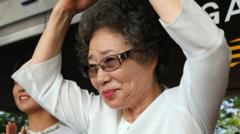South Korean cafes are adapting to the phenomenon of 'Cagongjok,' where patrons occupy seats for extended periods to study or work, sparking debates on comfort and cafe culture. Major chains like Starbucks are issuing guidelines, while some independent cafes are enforcing stricter policies, reflecting a complex relationship between student needs and customer experience.
South Korean Cafes Struggle to Balance Study Culture with Customer Comfort

South Korean Cafes Struggle to Balance Study Culture with Customer Comfort
With the rising trend of 'Cagongjok,' cafes in South Korea face challenges accommodating students and workers without compromising the atmosphere for other patrons.
In the upscale neighborhood of Daechi, Seoul, cafe owner Hyun Sung-joo is facing a dilemma as customers increasingly adopt the 'Cagongjok' lifestyle. This term refers to young South Koreans who prefer to study or work in cafes, creating pressure on cafe owners due to high rents and the phenomenon of patrons occupying spaces for excessive durations. One customer, for instance, took over a table with two laptops and a six-port power strip, prompting Hyun to disable power access to curb excessive use of his cafe's resources.
The cultural trend of Cagongjok, particularly in areas populated by students and young workers, has surged disproportionately compared to Western counterparts, where cafes are primarily social hubs. Starbucks Korea has recognized the challenge and recently implemented guidelines aimed at addressing extreme cases of cafe space monopolization. While they emphasize a supportive environment for study, they will intervene only when necessary to maintain a balance.
On a Thursday evening in Gangnam, the atmosphere in a Starbucks remained serene with students quietly focused on their work. One 18-year-old dropout shared her routine of spending hours at the cafe prepping for the university entrance exam, while some customers frequently left their belongings unattended, suggesting that the new guidelines have not dramatically changed patron behavior.
Public reaction to Starbucks' new policies has been divided; many appreciate the initiative as a long-overdue adjustment to restore cafe norms. Others feel the change is an overreaction, signifying a departure from the chain's previously relaxed approach. The increase in the number of cafes in South Korea, which has surged by 48% in five years, has fueled discussions on the necessity of addressing how shared spaces are utilized.
Some independent cafes have tailored their policies to deal with the seat monopolizing issue. Hyun remains open to accommodating Cagongjok as long as patrons act respectfully, while another cafe owner, wishing to remain anonymous, enacted a "No Study Zone" due to constant complaints. This rule limits study time to two hours for non-regular customers, ensuring space remains available for everyone.
The motivations behind Cagongjok go beyond mere preference for cafes over libraries. For young individuals like Yu-jin Mo, a cafe symbolizes safety and stability in contrast to their past, prompting them to seek comfort in these public spaces. Professor Choi Ra-young, an educator at Ansan University, characterizes Cagongjok as a byproduct of South Korea’s competitive climate, indicating that students and job seekers share these cafes to escape pressures experienced elsewhere.
Going forward, both cafe chains and independent establishments may need to develop new frameworks to respect the needs of both Cagongjok and casual patrons in order to maintain a harmonious atmosphere in these vital community spaces.


















